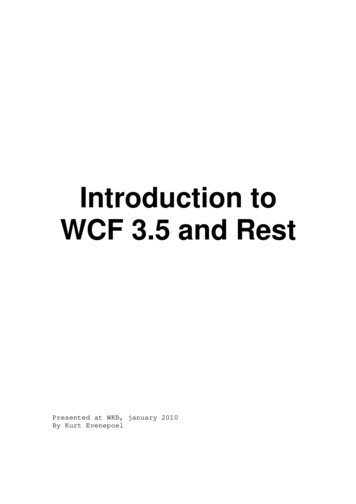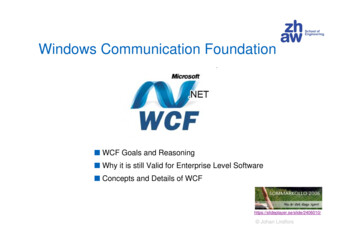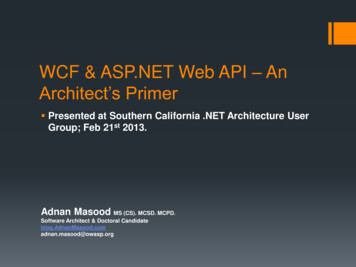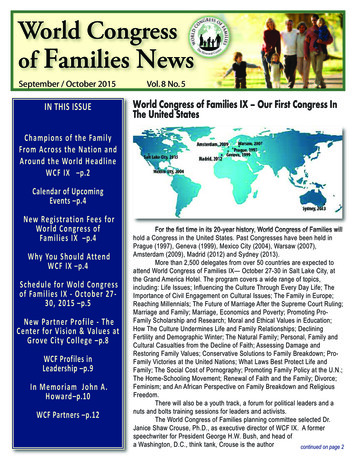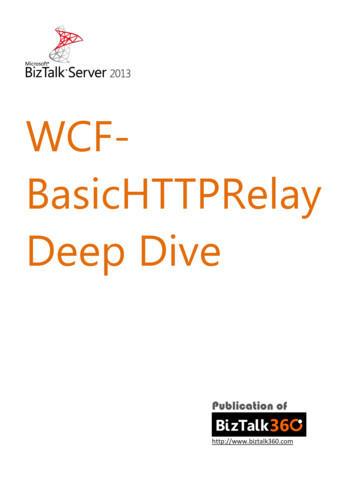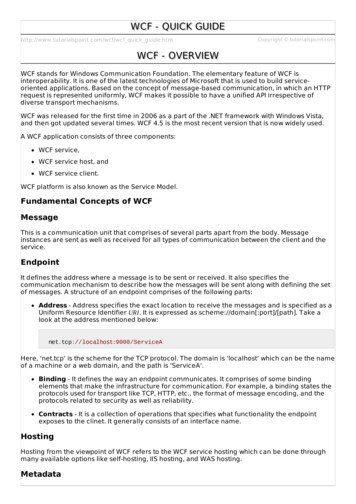
Transcription
WCF - QUICK GUIDEhttp://www.tutorialspoint.com/wcf/wcf quick guide.htmCopyright tutorialspoint.comWCF - OVERVIEWWCF stands for Windows Communication Foundation. The elementary feature of WCF isinteroperability. It is one of the latest technologies of Microsoft that is used to build serviceoriented applications. Based on the concept of message-based communication, in which an HTTPrequest is represented uniformly, WCF makes it possible to have a unified API irrespective ofdiverse transport mechanisms.WCF was released for the first time in 2006 as a part of the .NET framework with Windows Vista,and then got updated several times. WCF 4.5 is the most recent version that is now widely used.A WCF application consists of three components:WCF service,WCF service host, andWCF service client.WCF platform is also known as the Service Model.Fundamental Concepts of WCFMessageThis is a communication unit that comprises of several parts apart from the body. Messageinstances are sent as well as received for all types of communication between the client and theservice.EndpointIt defines the address where a message is to be sent or received. It also specifies thecommunication mechanism to describe how the messages will be sent along with defining the setof messages. A structure of an endpoint comprises of the following parts:Address - Address specifies the exact location to receive the messages and is specified as aUniform Resource Identifier URI. It is expressed as scheme://domain[:port]/[path]. Take alook at the address mentioned below:net.tcp://localhost:9000/ServiceAHere, 'net.tcp' is the scheme for the TCP protocol. The domain is 'localhost' which can be the nameof a machine or a web domain, and the path is 'ServiceA'.Binding - It defines the way an endpoint communicates. It comprises of some bindingelements that make the infrastructure for communication. For example, a binding states theprotocols used for transport like TCP, HTTP, etc., the format of message encoding, and theprotocols related to security as well as reliability.Contracts - It is a collection of operations that specifies what functionality the endpointexposes to the clinet. It generally consists of an interface name.HostingHosting from the viewpoint of WCF refers to the WCF service hosting which can be done throughmany available options like self-hosting, IIS hosting, and WAS hosting.Metadata
This is a significant concept of WCF, as it facilitates easy interaction between a client applicationand a WCF service. Normally, metadata for a WCF service is generated automatically whenenabled, and this is done by inspection of service and its endpoints.WCF ClientA client application that gets created for exposing the service operations in the form of methods isknown as a WCF client. This can be hosted by any application, even the one that does servicehosting.ChannelChannel is a medium through which a client communicates with a service. Different types ofchannels get stacked and are known as Channel Stacks.SOAPAlthough termed as ‘Simple Object Access Protocol’, SOAP is not a transport protocol; instead it isan XML document comprising of a header and body section.Advantages of WCFIt is interoperable with respect to other services. This is in sharp contrast to .NET Remoting inwhich both the client and the service must have .Net.WCF services offer enhanced reliability as well as security in comparison to ASMXActiveServerMethods web services.Implementing the security model and binding change in WCF do not require a major changein coding. Just a few configuration changes is required to meet the constraints.WCF has built-in logging mechanism whereas in other technologies, it is essential to do therequisite coding.WCF has integrated AJAX and support for JSON JavaScriptobjectnotation.It offers scalability and support for up-coming web service standards.It has a default security mechanism which is extremely robust.WCF - VERSUS WEB SERVICEThere are some major differences that exist between WCF and a Web service which are listedbelow.Attributes - WCF service is defined by ServiceContract and OperationContract attributes,whereas a web service is defined by WebService and WebMethod attributes.Protocols - WCF supports a range of protocols, i.e., HTTP, Named Pipes, TCP, and MSMQ,whereas a web service only supports HTTP protocol.Hosting Mechanisms - Various activation mechanisms are there for WCF hosting, i.e., IISInternetInformationService, WAS WindowsActivationService, Self-hosting and Windows Service, but aweb service is hosted only by IIS.Services - WCF supports a robust security, trustworthy messaging, transaction andinteroperability, while a web service only supports security services.Serializer - WCF Supports DataContract serializer by employingSystem.Runtime.Serialization, whereas a web service supports XML serializer by making useof System.Xml.Serialization.Tools - ServiceMetadata tool svcutil. exe is used for client generation for a WCF service, whileWSDL.EXE tool is used for generating the same for a web service.
Exception Handling - In WCF, unhandled exceptions are handled in a better way by makinguse of FaultContract. They do not return to the client like in a web service as SOAP faults.Hash Table - It is possible to serialize a Hash Table in WCF, but this is not the case in a webservice.Bindings - WCF supports several types of bindings like BasicHttpBinding,WSDualHttpBinding, WSHttpBinding, etc., while a web service supports only SOAP or XML.Multithreading - WCF supports multithreading by using the ServiceBehavior Class, whereasthis is not supported in a web service.Duplex Service Operations - WCF supports duplex service operations apart fromsupporting one-way and request-response service operations, whereas a web service doesnot support duplex service operations.WCF - DEVELOPERS TOOLSFor developing a WCF service application, there are mainly two tools – Microsoft Visual Studio andCodePlex. Microsoft Visual Studio is a complete package of development tools, necessary fordeveloping a large number of diverse applications like ASP.NET web applications, desktopapplications, mobile applications, and many more.Microsoft Visual Studio uses the .NET framework functionality. CodePlex on the other hand is anopen-source project hosting site of Microsoft that offers several free tools for WCF serviceapplication development.Microsoft Visual StudioThere are many editions of Microsoft Visual Studio and initially it VisualStudio2005 was not an ardentsupporter of WCF development. At present, Visual Studio 2008 is the only Microsoft IDE availablefor the development of WCF service applications.Nowadays, the latest version of Microsoft Visual Studio 2010 is also a preferred tool for developingWCF service application. There is also a readymade template in Visual Studio for developing WCFservice application.Selection of such a template leads to addition of files for the following purposes:Service contractService implementationService configurationRequisite attributes get added automatically and a simple "Hello World" service gets created byMicrosoft Visual Studio without even writing any code.CodePlexCodePlex was launched by Microsoft in June 2006 and since then, it has been used by a largenumber of developers across the world to create .NET projects successfully. Some of the toolsoffered by CodePlex for developing WCF service applications are as follows:wscf.blue - This is a Microsoft Visual Studio add-in, and also "contract-first" developmenttoolset that facilitates the defining of the WCF service operations, and generating a codeskeleton accordingly. An important link for the same is : http://wscfblue.codeplex.com/.WCFProxyGenerator - This is also a Microsoft Visual Studio add-in. The tool is used toextend the client-side generation and offer additional error handling. For having moreinformation regarding this particular development tool, visithttp://wcfproxygenerator.codeplex.comWCFMock - Testing of WCF service can be a complicating task and this development tooloffers a convenient solution for the unit testing of WCF services by its useful classes. Formore information regarding this tool, visit http://wcfmock.codeplex.com/
Another free tool for the development of WCF service applications in an easy manner isWCFStorm. Its LITE version offers many striking features for dynamically invoking and testing WCFservices, editing the service binding, modifying WCF URL endpoint, etc.WCF - ARCHITECTUREWCF has a layered architecture that offers ample support for developing various distributedapplications. The architecture is explained below in detail.ContractsThe contracts layer is just next to the application layer and contains information similar to that of areal-world contract that specifies the operation of a service and the kind of accessible informationit will make. Contracts are basically of four types discussed below in brief:Service contract - This contract provides information to the client as well as to the outerworld about the offerings of the endpoint, and the protocols to be used in the communicationprocess.Data contract - The data exchanged by a service is defined by a data contract. Both theclient and the service has to be in agreement with the data contract.
Message contract - A data contract is controlled by a message contract. It primarily doesthe customization of the type formatting of the SOAP message parameters. Here, it should bementioned that WCF employs SOAP format for the purpose of communication. SOAP standsfor Simple Object Access Protocol.Policy and Binding - There are certain pre-conditions for communication with a service,and such conditions are defined by policy and binding contract. A client needs to follow thiscontract.Service RuntimeThe service runtime layer is just below the contracts layer. It specifies the various servicebehaviors that occur during runtime. There are many types of behaviors that can undergoconfiguration and come under the service runtime.Throttling Behavior - Manages the number of messages processed.Error Behavior - Defines the result of any internal service error occurrence.Metadata Behavior - Specifies the availability of metadata to the outside world.Instance Behavior - Defines the number of instances that needs to be created to makethem available for the client.Transaction Behavior - Enables a change in transaction state in case of any failure.Dispatch Behavior - Controls the way by which a message gets processed by theinfrastructure of WCF.Concurrency Behavior - Controls the functions that run parallel during a client-servercommunication.Parameter Filtering - Features the process of validation of parameters to a method beforeit gets invoked.MessagingThis layer, composed of several channels, mainly deals with the message content to becommunicated between two endpoints. A set of channels form a channel stack and the two majortypes of channels that comprise the channel stack are the following ones:Transport Channels - These channels are present at the bottom of a stack and areaccountable for sending and receiving messages using transport protocols like HTTP, TCP,Peer-to-Peer, Named Pipes, and MSMQ.Protocol Channels - Present at the top of a stack, these channels also known as layeredchannels, implement wire-level protocols by modifying messages.Activation and HostingThe last layer of WCF architecture is the place where services are actually hosted or can beexecuted for easy access by the client. This is done by various mechanisms discussed below inbrief.IIS - IIS stands for Internet Information Service. It offers a myriad of advantages using theHTTP protocol by a service. Here, it is not required to have the host code for activating theservice code; instead, the service code gets activated automatically.Windows Activation Service - This is popularly known as WAS and comes with IIS 7.0. BothHTTP and non-HTTP based communication is possible here by using TCP or Namedpipeprotocols.Self-hostingThis is a mechanism by which a WCF service gets self-hosted as a consoleapplication. This mechanism offers amazing flexibility in terms of choosing the desiredprotocols and setting own addressing scheme.Windows Service - Hosting a WCF service with this mechanism is advantageous, as the
services then remain activated and accessible to the client due to no runtime activation.WCF - CREATING WCF SERVICECreating a WCF service is a simple task using Microsoft Visual Studio 2012. Given below is the stepby-step method for creating a WCF service along with all the requisite coding, to understand theconcept in a better way.Launch Visual Studio 2012.Click on new project, then in Visual C# tab, select WCF option.A WCF service is created that performs basic arithmetic operations like addition, subtraction,multiplication, and division. The main code is in two different files – one interface and one class.A WCF contains one or more interfaces and its implemented pace WcfServiceLibrary1{// NOTE: You can use the "Rename" command on the "Refactor" menu to// change the interface name "IService1" in both code and config file // together.[ServiceContract]Public interface IService1{[OperationContract]int sum(int num1, int num2);[OperationContract]int Subtract(int num1, int num2);[OperationContract]int Multiply(int num1, int num2);[OperationContract]int Divide(int num1, int num2);
}// Use a data contract as illustrated in the sample below to add// composite types to service operations.[DataContract]Public class CompositeType{Bool boolValue true;String stringValue "Hello ";[DataMember]Public bool BoolValue{get { return boolValue; }set { boolValue value; }}[DataMember]Public string StringValue{get { return stringValue; }set { stringValue value; }}}}The code behind its class is given below.using m.ServiceModel;usingSystem.Text;namespace WcfServiceLibrary1{// NOTE: You can use the "Rename" command on the "Refactor" menu to // change theclass name "Service1" in both code and config file// together.publicclassService1 :IService1{/// This Function Return summation of two integer numberspublicint sum(int num1, int num2){return num1 num2;}// This function returns subtraction of two numbers.// If num1 is smaller than number two then this function returns 0publicint Subtract(int num1, int num2){if (num1 num2){return num1 - num2;}else{return 0;}}// This function returns multiplication of two integer numbers.publicint Multiply(int num1, int num2){
return num1 * num2;}// This function returns integer value of two integer number.// If num2 is 0 then this function returns 1.publicintDivide(int num1, int num2){if (num2 ! 0){return (num1 / num2);}else{return 1;}}}}To run this service, click the Start button in Visual Studio.While we run this service, the following screen appears.
On clicking the sum method, the following page opens. Here, you can enter any two integernumbers and click on the Invoke button. The service will return the summation of those twonumbers.Like summation, we can perform all other arithmetic operations which are listed in the menu. Andhere are the snaps for them.The following page appears on clicking the Subtract method. Enter the integer numbers, click theInvoke button, and get the output as shown here:
The following page appears on clicking the Multiply method. Enter the integer numbers, click theInvoke button, and get the output as shown here:The following page appears on clicking the Divide method. Enter the integer numbers, click theInvoke button, and get the output as shown here:
Once the service is called, you can switch between them directly from here.WCF - HOSTING WCF SERVICEAfter creating a WCF service, the next step is to host it so that the client applications can consumeit. This is known as WCF service hosting. A WCF service can be hosted by using any of the four waysgiven below:IIS Hosting - IIS stands for Internet Information Services. Its working model is similar to thatof ASP.NET while hosting a WCF service. The best feature of IIS hosting is that the serviceactivation is processed automatically. IIS hosting also offers process health monitoring, idleshutdown, process recycling, and many more features to facilitate a WCF service hosting.Self-Hosting - When a WCF service is hosted in a managed application, it is known as selfhosting. It requires a developer to write the requisite coding for ServiceHost initialization. Inself-hosting, a WCF service can be hosted in a variety of applications like Consoleapplication, Windows form, etc.WAS Hosting - Hosting a WCF service in Windows Activation Service WAS is mostadvantageous because of its features such as process recycling, idle time management,common configuration system, and support for HTTP, TCP, etc.Windows Service Hosting - For local system clients, it is best to host WCF service as awindow service and this is known as Window Service Hosting. All the versions of Windowssupport this type of hosting and here, the Service Control Manager can control the processlifecycle of the WCF service.WCF - IIS HOSTINGHosting a WCF service in IIS InternetInformationServices is a step-by-step process. IIS Hosting isillustrated below in detail with the desired coding as well as screenshots to understand the process.
Step 1 : Start Visual Studio 2012 and click File - New - Web site. Select “WCF Service” andLocation as http. This will host the service in IIS. Click OK.Step 2 : The code behind the interface is given Model.Web;System.Text;// NOTE: You can use the "Rename" command on the "Refactor" menu to// change the interface name "IService" in both code and config file// together.[ServiceContract]Public interface IService{[OperationContract]String GetData(int value);[OperationContract]CompositeType GetDataUsingDataContract(CompositeType composite);// TODO: Add your service operations here}// Use a data contract as illustrated in the sample below to add// composite types to service operations.[DataContract]Public class CompositeType{Bool boolValue true;String stringValue "Hello ";[DataMember]Public bool BoolValue{get { return boolValue; }set { boolValue value; }}
[DataMember]Public string StringValue{get { return stringValue; }set { stringValue value; }}}Step 3 : The code behind the class file is given Model.Web;System.Text;// NOTE: You can use the "Rename" command on the "Refactor" menu to// change the class name "Service" in code, svc and config file// together.Public class Service : IService{Public string GetData(int value){Return string.Format("You entered: {0}", value);}Public CompositeType GetDataUsingDataContract(CompositeType composite){if (composite if (composite.BoolValue){composite.StringValue "Suffix";}return composite;}}Step 4 : Service file . svc contains the name of the service and the code behind the file name. Thisfile is used to know about the service.
%@ ServiceHost Language "C#" Debug "true" Service "Service"CodeBehind " /App Code/Service.cs" % Step 5 : Server-side configurations are mentioned in the config file. Here, there is a mention ofonly one end-point which is configured to 'wsHttpBinding'; we can also have multiple endpointswith different bindings. Since we are going to host in IIS, we have to use only http binding. ?xml version "1.0"? configuration !-Note: As an alternative to hand editing this file you can use theweb admin tool to configure settings for your application. Usethe Website- Asp.Net Configuration option in Visual Studio.A full list of settings and comments can be found inmachine.config.comments usually located in\Windows\Microsoft.Net\Framework\vx.x\Config-- configSections sectionGroup name "system.web.extensions"ype onGroup,System.Web.Extensions, Version 3.5.0.0, Culture neutral,PublicKeyToken 31BF3856AD364E35" sectionGroup name "scripting"type stem.Web.Extensions, Version 3.5.0.0, Culture neutral,PublicKeyToken 31BF3856AD364E35" section name "scriptResourceHandler"type andlerSection,System.Web.Extensions, Version 3.5.0.0,Culture neutral, PublicKeyToken 31BF3856AD364E35"requirePermission "false"allowDefinition "MachineToApplication"/ sectionGroup name "webServices"type ionGroup,System.Web.Extensions, Version 3.5.0.0,Culture neutral, PublicKeyToken 31BF3856AD364E35" section name "jsonSerialization"type onSection,System.Web.Extensions, Version 3.5.0.0,Culture neutral, PublicKeyToken 31BF3856AD364E35"requirePermission "false" allowDefinition "Everywhere"/ section name "profileService"type ection,System.Web.Extensions, Version 3.5.0.0,Culture neutral, PublicKeyToken 31BF3856AD364E35"requirePermission "false"allowDefinition "MachineToApplication"/ section name "authenticationService"type erviceSection,System.Web.Extensions, Version 3.5.0.0,Culture neutral, PublicKeyToken 31BF3856AD364E35"requirePermission "false"allowDefinition "MachineToApplication"/ section name "roleService"type ion,System.Web.Extensions, Version 3.5.0.0,Culture neutral, PublicKeyToken 31BF3856AD364E35"requirePermission "false"allowDefinition "MachineToApplication"/
/sectionGroup /sectionGroup /sectionGroup /configSections appSettings/ connectionStrings/ system.web !-Set compilation debug "true" to insert debuggingsymbols into the compiled page. Because thisaffects performance, set this value to true onlyduring development.-- compilation debug "true" assemblies add assembly "System.Core, Version 3.5.0.0, Culture neutral,PublicKeyToken B77A5C561934E089"/ add assembly "System.Web.Extensions, Version 3.5.0.0,Culture neutral, PublicKeyToken 31BF3856AD364E35"/ add assembly "System.Data.DataSetExtensions, Version 3.5.0.0,Culture neutral, PublicKeyToken B77A5C561934E089"/ add assembly "System.Web.Extensions, Version 3.5.0.0,Culture neutral, PublicKeyToken 31BF3856AD364E35"/ add assembly "System.Xml.Linq, Version 3.5.0.0, Culture neutral,PublicKeyToken B77A5C561934E089"/ /assemblies /compilation !-The authentication section enables configurationof the security authentication mode used byASP.NET to identify an incoming user.-- authentication mode "Windows"/ !-The customErrors section enables configurationof what to do if/when an unhandled error occursduring the execution of a request. Specifically,it enables developers to configure html error pagesto be displayed in place of a error stack trace. customErrors mode "RemoteOnly"defaultRedirect "GenericErrorPage.htm" error statusCode "403" redirect "NoAccess.htm" / error statusCode "404" redirect "FileNotFound.htm" / /customErrors -- pages controls add tagPrefix "asp" namespace "System.Web.UI"assembly "System.Web.Extensions, Version 3.5.0.0,Culture neutral, PublicKeyToken 31BF3856AD364E35"/ add tagPrefix "asp" namespace "System.Web.UI.WebControls"assembly "System.Web.Extensions, Version 3.5.0.0,Culture neutral, PublicKeyToken 31BF3856AD364E35"/ /controls /pages httpHandlers remove verb "*" path "*.asmx"/ add verb "*" path "*.asmx" validate "false"type ystem.Web.Extensions, Version 3.5.0.0, Culture neutral,PublicKeyToken 31BF3856AD364E35"/ add verb "*" path "* AppService.axd" validate "false"type ystem.Web.Extensions, Version 3.5.0.0, Culture neutral,PublicKeyToken 31BF3856AD364E35"/ add verb "GET,HEAD" path "ScriptResource.axd"
type Web.Extensions, Version 3.5.0.0, Culture neutral,PublicKeyToken 31BF3856AD364E35" validate "false"/ /httpHandlers httpModules add name "ScriptModule"type sions, Version 3.5.0.0, Culture neutral,PublicKeyToken 31BF3856AD364E35"/ /httpModules /system.web system.codedom compilers compiler language "c#;cs;csharp" extension ".cs"warningLevel "4" type "Microsoft.CSharp.CSharpCodeProvider,System, Version 2.0.0.0, Culture neutral,PublicKeyToken b77a5c561934e089" providerOption name "CompilerVersion" value "v3.5"/ providerOption name "WarnAsError" value "false"/ /compiler compiler language "vb;vbs;visualbasic;vbscript" extension ".vb"warningLevel "4" type "Microsoft.VisualBasic.VBCodeProvider,System, Version 2.0.0.0, Culture neutral,PublicKeyToken b77a5c561934e089" providerOption name "CompilerVersion" value "v3.5"/ providerOption name "OptionInfer" value "true"/ providerOption name "WarnAsError" value "false"/ /compiler /compilers /system.codedom !-The system.webServer section is required for running ASP.NET AJAXunder Internet Information Services 7.0.It is not necessary for previous version of IIS.-- system.webServer validation validateIntegratedModeConfiguration "false"/ modules remove name "ScriptModule"/ add name "ScriptModule" preCondition "managedHandler"type sions, Version 3.5.0.0, Culture neutral,PublicKeyToken 31BF3856AD364E35"/ /modules handlers remove name "WebServiceHandlerFactory-Integrated"/ remove name "ScriptHandlerFactory"/ remove name "ScriptHandlerFactoryAppServices"/ remove name "ScriptResource"/ add name "ScriptHandlerFactory" verb "*" path "*.asmx"preCondition "integratedMode"type ystem.Web.Extensions, Version 3.5.0.0, Culture neutral,PublicKeyToken 31BF3856AD364E35"/ add name "ScriptHandlerFactoryAppServices"verb "*" path "* AppService.axd" preCondition "integratedMode"type ystem.Web.Extensions, Version 3.5.0.0, Culture neutral,PublicKeyToken 31BF3856AD364E35"/ ' add name "ScriptResource" preCondition "integratedMode"verb "GET,HEAD" path "ScriptResource.axd"type Web.Extensions, Version 3.5.0.0, Culture neutral,PublicKeyToken 31BF3856AD364E35"/ /handlers !--To browse web app root directory during debugging,set the value below to true. Set to false before deployment to
avoid disclosing web app folder information.-- directoryBrowse enabled "true"/ /system.webServer runtime assemblyBinding appliesTo "v2.0.05727" xmlns "urn:schemas-microsoft-com:asm.v1" dependentAssembly assemblyIdentity name "System.Web.Extensions"publicKeyToken "31bf3856ad364e35"/ bindingRedirect oldVersion "1.0.0.0-1.1.0.0"newVersion "3.5.0.0"/ /dependentAssembly dependentAssembly assemblyIdentity name "System.Web.Extensions.Design"publicKeyToken "31bf3856ad364e35"/ bindingRedirect oldVersion "1.0.0.0-1.1.0.0"newVersion "3.5.0.0"/ /dependentAssembly /assemblyBinding /runtime system.serviceModel services service name "Service" behaviorConfiguration "ServiceBehavior" !-- Service Endpoints -- endpoint address "" binding "basicHttpBinding" contract "IService" !-Upon deployment, the following identity element should be removed orreplacedto reflect the identity under which the deployed service runs. If removed,WCF will infer an appropriate identity automatically.-- identity dns value "localhost"/ /identity /endpoint endpoint address "mex" binding "mexHttpBinding" contract "IMetadataExchange"/ /service /services behaviors serviceBehaviors behavior name "ServiceBehavior" !-- To avoid disclosing metadata information, set the value belowto false before deployment -- serviceMetadata httpGetEnabled "true"/ !-- To receive exception details in faults for debugging purposes,set the value below to true. Set to false before deployment tavoiddisclosing exception information -- serviceDebug includeExceptionDetailInFaults "false"/ /behavior /serviceBehaviors /behaviors /system.serviceModel /configuration Step 6:You need to mention the service file name, along with the Address mentioned in the configfile. The screenshot of IIS is given here.Click Start - run - inetmgr which will open the following window.
Step 7 : Run the application which will produce the following screen.WCF - SELF HOSTINGHere, the WCF service is hosted in a console application. Given below is the process with suitablesteps in a sequential manner that explains the entire process.Step 1 : First, let's create the Service contract and its implementation. Create a consoleapplication and name it as MyCalculatorService. This is a simple service to return the addition oftwo numbers.
Step 2 : Now, right click on the References in the Solution Explorer and click Add References. Thefollowing window opens; add System.ServiceModel reference to the project.Step 3 : Create an ISimpleCalculator interface, Add ServiceContract and OperationContractattribute to the class and function as shown below. You will know more about these contracts in thelater session. These contracts will expose the method to the outside world for using this service.Step 4 : The code behind this file is as rviceModel;namespace MyCalculatorWCFService{[ServiceContract()]Public interface ISimpleCalculator{[OperationContract()]int Add(int num1, int num2);}}Step 5 :
Dispatch Behavior - Controls the way by which a message gets processed by the infrastructure of WCF. Concurrency Behavior - Controls the functions that run parallel during a client-server communication. Parameter Filtering - Features the process of validation of parameters to a method before it gets invoked. Messaging
